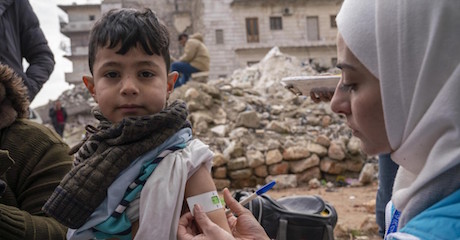More than 36,000 are dead and tens of thousands injured after twin earthquakes devastated Turkey and Syria on Feb. 6, 2023. As the search and rescue phase winds down, the scale up of the humanitarian response is accelerating rapidly. UNICEF teams are on the ground, working with partners to reach children and families with lifesaving assistance.
In the city of Aleppo in northern Syria, UNICEF-supported mobile clinics are providing children with health consultations, free prescriptions, medical referrals and other specialized medical services. UNICEF health teams screen children under 5 and pregnant women for malnutrition and distribute nutrition supplements.
Parents and children wait to see a UNICEF-supported health team at a mobile clinic in the city of Aleppo, northwest Syria. © UNICEF/UN0781578/Al-Asad
The mobile health and nutrition teams make the rounds, visiting four or five shelters each. Worried parents line up to wait their turn with their children in their arms.
Ahmad brings his 2-year-old daughter, Amirah, to be screened for malnutrition at a UNICEF-supported mobile health clinic in the neighborhood of Alsaheen, Aleppo. © UNICEF/UN0781273/Al-Asadi
Ahmad — still recovering from the shock of Feb. 6 and its aftermath — brought his 2-year-old daughter, Amirah, to be screened for malnutrition at a mobile clinic in Aleppo’s Alsaheen neighborhood.
“It was indescribable,” he said, flashing back to the instant he was jolted awake by the first earthquake at 4:15 a.m. “I grabbed the children, and we immediately left our home.” Their building was badly damaged, so the family is staying at his sister’s house for the time being.
Faten, 6, Adbulkhaleq, 13, and their cousin Hamzeh, 5, are staying at a mosque turned shelter in the city of Aleppo, Syria, following the catastrophic Feb. 6 earthquakes. © UNICEF/UN0781603/Al-Asad
At a mosque turned collective shelter in the city of Aleppo’s Sleiman Alhalabi neighborhood, Yasmine, a mother of two, described the first terrifying moments of the earthquake, as she fled with 6-year-old Faten and 13-year-old Abdulkhaleq.
“I heard the walls of the apartment on the floor above us crumble, so we rushed out. I saw death with my own eyes. When I held my children’s hands down the staircase, my legs were shaking. I remember the building smelled like mold. Apartments were flooding and others were collapsing.
“We didn’t have time to grab any of our stuff, so we came here,” Yvonne continued. “My sister-in-law brought us three blankets to keep us warm here. I hope we can go back home soon.”
Faiza, 26, is a UNICEF-support health educator working in Aleppo, Syria, with children and families displaced by the Feb. 6 earthquakes. © UNICEF/UN0781604/Al-Asadi
The families at the shelter “are going through very tough times,” said Faiza, 26, a UNICEF-supported health educator. “They are very anxious, but we’re trying to support them as much as possible.”
“I’m saddened the most to see displaced children in lightweight clothing, despite the cold,” Faiza continued. “They escaped with nothing but the clothes on their backs. Pregnant and lactating women are also vulnerable in these conditions. Seeing my baby, Wateen, in good health is what’s helping me cope after what happened. It keeps me motivated to support other children and mothers.”
Molham, 7, Hala, 4, and Nour, 13, wait to see a UNICEF health team in Aleppo’s Sleiman Alhalabbi neighborhood. © UNICEF/UN0781602/Al-Asadi
Nearby, Hanan waited for a health consultation for her children: Molham, 7, Hala, 4, and Nour, 13. “I was displaced before more than once, because of the conflict,” Hanan said. “I’m really tired, but thankful my family is safe.”
A father holds his 2-year-old as a UNICEF mobile health team member measures the child’s mid-upper arm to screen for malnutrition. © UNICEF/UN0781278/Al-Asadi
In Alsaheen, Hiba, a mobile health team leader, screened Sondos, 2, for malnutrition using a mid-upper arm circumference (MUAC) tape. The measuring tape’s reading was yellow, a warning that Sondos is at risk of acute malnutrition. A reading in red indicates that a child is suffering from severe wasting, the most visible and life-threatening form of malnutrition, and must be referred to a nutrition facility for treatment.
On Feb. 10, 2023, from left: Amr, 24, Fayzeh, Hiba, Sameh, 24, and Mohammad, 28, stand in front of the rubble of a building that collapsed during the earthquake in Aleppo’s Alsalheen neighborhood. © UNICEF/UN0781283/Al-Asadi
Just a few hours after the earthquake hit, Hiba left her two children, 6-year-old Jad and 8-year-old Spinta, at home with her husband and rushed to meet with her team to begin supporting children impacted by the quake. “Feeling incapable to do much is the hardest thing,” she said. “I’m responsible for keeping my little ones safe and I felt equally responsible to help other children in need.
“To support my team members, I must manage how I feel and stay in good spirits despite everything. It’s not easy! We have lost a member of our team. May her soul rest in peace. And a couple of our team members lost their homes,” Hiba added.
“During these past few days, when I go to sleep, I feel that I’m never sure what tomorrow will bring. Uncertainty is everywhere, but we keep going to support the people who need us.”
Help UNICEF reach more children affected by the earthquake in Syria and Turkey. Your contribution can make a difference.
Top photo: On Feb. 10, 2023, Hamzeh, 4, is screened for malnutrition by Hiba, a UNICEF-supported mobile health team leader, using a mid-upper arm circumference (MUAC) tape, in the Alsalheen neighborhood of the city of Aleppo, northern Syria. © UNICEF/UN0781272/Al-Asadi
